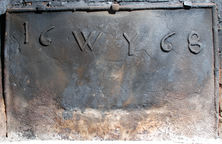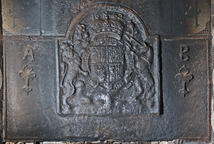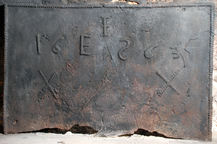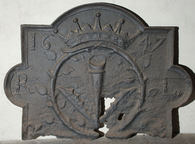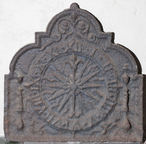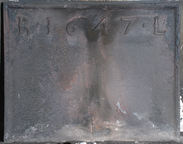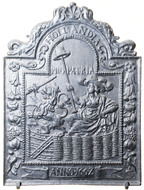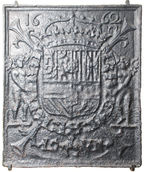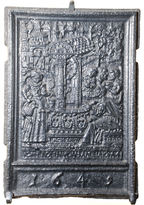-
504
Description: Rectangular; twisted rope edging (top and sides); along upper half of plate, date split with initials in between.
Notes: The initials are likely to be those of William Yalden (d.1674), an ironmaster who was active in north-west Sussex and south-west Surrey where this and other similar firebacks have been noted.
Inscription: 16 WY 68
- Decoration tags:
- rectangular (shape)
- rope (edging)
- individual letters
- individual numbers
- text
Manufactured: in 1668 in the Weald area of England.
Current location: in private hands, Northchapel, West Sussex, England.
- Attached to series:
- William Yalden series
- Date & initials firebacks
-
1144
Description: Composite; arched rectangular shaped, armorial fireback, cavetto edging, with Stuart Royal arms, garter, supporters, crown and motto, and 1662 date above crown; this overlies a rectangular plate with fillet edging; top centre in the space each side of the central shield, an initial letter - A to left, B to right - each above a fleur-de-lys, its stem terminating in a small buckle.
Notes: Several firebacks have incorporated the same Stuart royal shield, which probably originally dated to 1619, but with the date altered. A similar fireback, but without the initials and fleurs-de-lys, dated 1661, and reputed to have come from the Totsey, the old guildhall at the market cross in Gloucester, is illustrated in Ames, 1980, 23; possibly the same fireback was reported by the late David Bick to be at The Grange, Minsterworth, Gloucestershire (demolished in the late 1960s).
Inscription: 16 62 / [Garter motto (illeg.)] / A B
Arms: English Stuart royal
- Decoration tags:
- rectangular with round arch (shape)
- fillet (edging)
- carved stamps
- carved pattern panels
- composite
- individual letters
- heraldic
- armorial
- royal
- text
Manufactured: in 1662 possibly in the Forest of Dean area of England.
Current location: in private hands, Norton, Wiltshire, England.
Citation: Ames, A., 1980, Collecting Cast Iron (Ashbourne, Moorland Publishing).
Citation: Badeni, J., 22 Sep 1983, 'Whose Fireback?' [letter], Country Life, 174, 4492, p. 772.
-
505
Description: Rectangular; twisted rope edging (top and sides); inscription (‘S’ reversed) across upper middle of plate, with superscripted central ‘I’ (crossed) ; below each part of the date is a twisted rope saltire (145mm lengths).
Notes: A personal fireback, made to order; a similar commission by Giles Moore, Rector of Horsted Keynes, Sussex, in 1657, cost 13 shillings.
Inscription: I / 16 E S 63
- Decoration tags:
- rectangular (shape)
- rope (edging)
- simple stamps
- individual letters
- individual numbers
- apotropaic
- text
- objects
Manufactured: in 1663 in the Weald area of England.
Current location: in private hands, Ockley, Surrey, England.
- Attached to series:
- Date & initials firebacks
-
511
Description: Rectangular with semi-circular protrusions on the top and sides; cavetto edging; a pheon (a downward-pointing arrow head barbed on the inner edge), within a wreath, an earl’s coronet above; the date on either side of the coronet; the initials on left and right sides; a fleur de lys in each bottom corner.
Notes: The wreathed pheon and coronet are cast from a different pattern to the 1626 and 1630 plates.
Copies of this fireback are known.
Inscription: 16 47 / R L
- Decoration tags:
- rectangular with round arch (shape)
- cavetto (edging)
- whole carved pattern
- planklines
- heraldic
- text
Manufactured: in 1647 possibly at Robertsbridge Furnace, Salehurst in the Weald area of England.
Current location: Penshurst Place, Penshurst, Kent, England.
- Attached to series:
- Earl of Leicester series
- Personal firebacks
-
512
Description: Double arched rectangular shaped; ovolo edging; central clock dial with Roman numerals separated by stops, sunburst inside, single hand with fleur de lys pointer; teardrop weights, with finials above, suspended from each side; symmetrical tendrils above; date split below dial.
Notes: One of the ‘hooked 1’ series of firebacks; two versions exist of this fireback, the other without finials above the suspended weights.
Copies of this fireback are known.
Inscription: I · II · III · IIII · V · VI · VII · VIII · IX · X · XI · XII / 16 5 [..]
- Decoration tags:
- rectangular with round arch (shape)
- ovolo (edging)
- whole carved pattern
- pictorial
- text
- objects
Manufactured: in 1652 possibly at Brede Furnace in the Weald area of England.
Current location: Penshurst Place, Penshurst, Kent, England.
Citation: Gardner, J. S., 1898, 'Iron Casting in the Weald', Archaeologia, 56, 1, pp. 133-164.
- Attached to series:
- Hooked '1' series
- Brede group
-
514
Description: Rectangular; ovolo-moulded edging (top and sides); inscription along top of plate.
Notes: The initials may relate to Robert, 2nd Earl of Leicester.
Inscription: R · 1647 · L
- Decoration tags:
- rectangular (shape)
- ovolo (edging)
- individual letters
- individual numbers
- text
Manufactured: in 1647 in the Weald area of England.
Current location: Penshurst Place, Penshurst, Kent, England.
- Attached to series:
- Date & initials firebacks
-
517
Description: Rectangular; ogee within broad fillet moulded edging; top centre, date between split initials, with small diamonds between date and initials and outside initials.
Inscription: T 1665 S
- Decoration tags:
- rectangular (shape)
- fillet and ogee (edging)
- text
Manufactured: in 1665 in the Weald area of England.
Current location: Penshurst Place, Penshurst, Kent, England.
- Attached to series:
- Date & initials firebacks
-
566
Description: Arched rectangular central panel; bead-on-fillet edging; wickerwork Garden of Holland (Hollandse Tuin) within which is seated a berobed female figure holding a cap of freedom on the end of a long pole; before her is the crowned heraldic lion of the States General of the Netherlands, clutching a sheaf of arrows in its left front paw; above are the words, Pro Patria; arched rectangular border with cavetto-moulded edging, with the word, Hollandia, in the arch, suspended from which are festoons of flowers and fruit and the date within a scroll on the bottom; on top, a scallop shell between two mirrored serpents.
Notes: An overtly patriotic theme with symbols of Dutch nationhood. Mitford collection, Petworth House.
Copies of this fireback are known.
Inscription: HOLLANDIA / PRO PATRIA / ANNO 1662
- Decoration tags:
- 'Dutch' (shape)
- cavetto (edging)
- whole carved pattern
- heraldic
- pictorial
- allegorical
- text
- humans
Manufactured: in 1662 in the Siegerland area of Germany.
Current location: Petworth House, Petworth, West Sussex, England.
Museum number: NT/PET/M/59 (part of the National Trust museum group)
- Attached to series:
- 'Dutch' Garden of Holland firebacks
-
524
Description: Rectangular; cavetto-moulded edging; shield, crown and supporters of King Philip IV of Spain, incorporating the arms of Castille and Leon, Aragon - Sicily, Granada, Portugal, Austria, Burgundy and Brabant; around the shield is the chain of the Order of the Golden Fleece; at the top, the date split by the crown; behind, crossed lilies.
Notes: By 1662 the arms of Portugal were redundant on the Spanish royal arms, but were retained until after the death of Philip IV; the word, LOVEN, indicates the particular association of this plate with the town of Leuven, the capital of Brabant in what was, at the time, part of the Spanish Netherlands. Mitford collection, Petworth House.
Inscription: 16 62 / LO VEN
Arms: King Philip IV of Spain
- Decoration tags:
- rectangular (shape)
- double fillet (edging)
- whole carved pattern
- individual numbers
- armorial
- royal
- text
Manufactured: in 1662 possibly in the Eifel area of Germany.
Current location: Petworth House, Petworth, West Sussex, England.
Museum number: NT/PET/M/78 (part of the National Trust museum group)
- Attached to series:
- Foreign armorial firebacks
-
550
Description: Rectangular; flanged edging; rectangular upper panel with cyma recta edging; pictorial scene of Jesus sitting at the well with the woman of Samaria, inscription along the bottom edge; lower inset rectangular panel with date in relief.
Notes: The inscription reads: From the maiden of Samaria - John 4. Mitford collection, Petworth House.
Inscription: VOM FROWLEIN VON SAMARIA JOH 4 / 1649
- Decoration tags:
- rectangular (shape)
- flanged (edging)
- whole carved pattern
- pictorial
- biblical
- text
Manufactured: in 1649 possibly in the Eifel area of Germany.
Current location: Petworth House, Petworth, West Sussex, England.
Museum number: NT/PET/M/92 (part of the National Trust museum group)
- Attached to series:
- Stoveplates
- Woman of Samaria stoveplates
